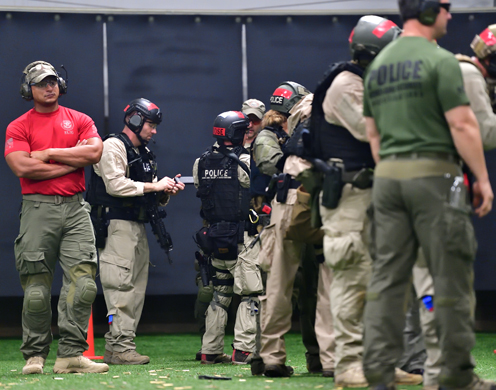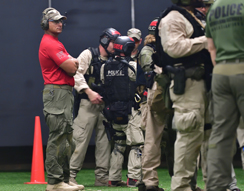Archived Content
In an effort to keep ICE.gov current, the archive contains content from a previous administration or is otherwise outdated. This information is archived and not reflective of current practice.
ICE OTTP instructor helps save life
Jason Gueringer experienced a lot while in the U.S. Army; however, in his 20 years of service, nothing compared to what happened recently while leading a defensive tactics course at Fort Benning, Georgia.
Gueringer, a firearms programs specialist and tactical instructor with ICE’s Office of Training and Tactical Programs (OTTP), was class coordinator for a group of officers with the DHS National Protection and Programs Directorate’s Federal Protective Service (FPS). Following the conclusion of the diagnostic portion of the training, which requires a physical fitness test and 1.5-mile run, Gueringer was giving further instructions when FPS Inspector Salvador Lujan suddenly collapsed.
“It was an image I won’t be able to get out of my head,” Gueringer said. “He turned blue and started having some convulsions, so we thought he was maybe having a seizure. Immediately after that he just stopped breathing.”
For the next 14 minutes, Gueringer and others on hand sprang into action. The seriousness of the situation became evident by the minute and with every attempt to help save their colleague.
Chest compressions? No breath.
Two shocks from the automated external defibrillator (AED) provided a glimmer of hope, but again, no heart rate.
Every other AED cycle, Gueringer continued chest compressions, taking turns with other FPS inspectors and rotating Lujan in and out of the rescue position.
The third AED shock was the charm as Lujan was resuscitated just as the EMS arrived to load Lujan in the ambulance and take him to the hospital. Upon arrival, Gueringer told the paramedics, cardiologists and the emergency doctors what had happened.
Lujan underwent emergency quadruple bypass surgery. It was revealed that he suffered a “widow maker” heart attack, one in which there is major blockage of the left anterior descending coronary artery that cuts off the blood supply to the majority of the heart. The survival rate is less than one percent. According to Gueringer, doctors informed the group that they had never seen a field AED help bring somebody back to life.
Gueringer didn’t know Lujan prior to the beginning of the course, but in an instant, they were connected forever. Going from one day seeing someone not breathing when you’re doing chest compressions to talking to them the next day in the hospital was a unique experience for him, and one he’ll never forget. Two weeks later, Lujan was out of the hospital and back at the class graduation meeting with all his friends and colleagues who had helped him.
“It was a real touching moment at graduation to have him there,” Gueringer said.
The quick reaction by Gueringer and the other officers saved Lujan’s life. More importantly, the knowledge of what to do in that situation was just as important. Gueringer has been through first aid training in the military and ranger first response training at ICE. Ironically, two months ago, he was just recertified with AED and CPR.
The events of that day served as a reminder of the need to have that skill.
“The biggest takeaway for me is the continued need for the first aid training that we get,” Gueringer said. “To have the training that saved another person’s life was the most endearing for me.”




